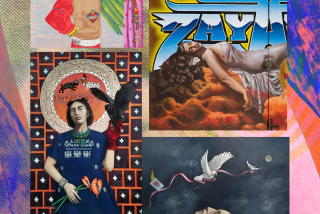Providing Insight
- Share via
“El Alma del Pueblo” at the Craft and Folk Art Museum claims to be the first survey of Spanish folk art ever organized in this country. Considering the nature of prejudice in the Americas the oversight seems sadly plausible. Anglo-centric northerners haven’t always been inclined to acknowledge Iberian contributions to their culture. At the same time, many Latin Americans consciously reject their Spanish heritage as a kind of mental revenge on the conquistadors.
The 200-work show is a generous if tardy historical revision. It adds significant aesthetic insight by living up to its subtitle, “Spanish Folk Art and Its Transformation in the Americas.” Past shows touching on the Spanish colonial era (1525-1810) left a sense of how this aesthetic cross-fertilization worked. Schematically put, indigenous Latino artisans were asked to approximate art in the Spanish courtly style. The resulting work was a hybrid of cosmopolitan Spain and the local Latino way of working.
Three carved figures in “El Alma” illustrate the point. All are variations on an image of the Holy Virgin. The one from Spain is clearly the work of a trained, poetic artist. Latin American versions have their own character. A Bolivian example is earthier; a Mexican one decorative and gently playful.
*
The exhibition, however, does more than confirm the standard model. It suggests an intriguing new twist on basic notions about what inspired this folk art.
Objects and catalog make it clear that Spain’s version is very much a product of place. Spain is ethnically, geographically and linguistically heterogeneous. Castilian, Catalan, Galician and Basque people each have distinctive ways of articulating--as the title says, “The Heart of the Place.” That means the folk artist isn’t an alienated loner like today’s urban outsider, his work is informed by clan values.
Local variations are apparent throughout the exhibition. A sailor’s footlocker from Barcelona aspires to be nothing more than what it is while an inland chair looks like a poor guy’s dream of a rich man’s roost. Votive objects all serve the function of giving thanks for divine intervention but take a wide variety of forms. A landlocked farmer would commission a picture in thanksgiving for his miraculous luck in not being kicked to death by a mule. Spain’s myriad seamen--including Christopher Columbus--offered ship models in gratitude for safe passage. Entertaining hand puppets and giant figures used in carnival pageants show local variations from Zaragosa to Toledo.
Still, one is struck by certain underlying characteristics that unite this work while separating it generically from its colonial inheritors. Spanish folk art varies from genre figures so skillful they look like scale models to satirical popular prints with a wicked irony not usually associated with folk art. There’s something studied, civilized and controlled about this work that points to a specific origin in canonical art history. A tusk is carved with figures. If they weren’t in 18th century costume they’d resemble something updated from an 8th century Carolingian manuscript. Aha. That’s it.
Continental Spanish folk art is completely informed by the Catholic art of the Middle Ages. It’s one of those insights that rewrites a chapter of one’s private history of aesthetics. It makes sense that whatever art the Spanish conquerors brought with them would be associated with their cover story of saving heathen souls. It explains a connection that is both factual and soulful between the two forms.
European medieval art has striking characteristics in common with the ritual art of pre-Columbian civilizations. Both tend to be ceremonial, decorative and hierarchical. A late 19th century Bolivian painting, “San Isidro Labrador” (Saint Isidore the Farmer), shows the saint as a giant Gulliver-esque gentleman farmer towering over his Lilliputian serfs. The painting is nearly 6 feet tall but in scale it’s like a miniature manuscript illumination writ large.
Finally, the hybrid of the Spanish and pre-Columbian traditions created an art of such vigor and flexibility that it remains viable in Latin America to this day.
Curatorial credit for this revealing show belongs to Marion Oettinger Jr., who organized it to travel for the San Antonio Museum of Art, where he’s senior curator.
*
* “El Alma del Pueblo,” Craft and Folk Art Museum, 5814 Wilshire Blvd., through March 31. (323) 937-4230.
More to Read
The biggest entertainment stories
Get our big stories about Hollywood, film, television, music, arts, culture and more right in your inbox as soon as they publish.
You may occasionally receive promotional content from the Los Angeles Times.










